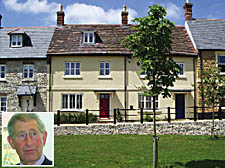|
|
 |
| |

Is Prince Charles’ Poundbury development in Dorset a model for Westminster? |
Barrack homes should be affordable for all
Mixed housing, not ‘ghettos’ for rich and poor, is what the West End urgently needs, argues Paul Dimoldenberg
SO far, the Chelsea Barracks debate has been dominated by design and architecture issues.
But the real issue about the future of the Chelsea Barracks site is not just about design: it is about who will benefit from the redevelopment of this massive site so close to the West End.
This is an opportunity to create a model development which brings a wide range of benefits for existing Pimlico residents as well as to new residents of the area. The Chelsea Barracks development must not become a place where only the rich can afford to live, no matter how well designed the buildings are.
There has been speculation in the press that the owners of the Chelsea Barracks want to negotiate away the elements in the planning brief which require on site affordable housing. The owners, it is said, want to build the affordable housing elsewhere or simply write a large cheque to the Council so that this problem goes away.
Labour believes that for the council to allow the owners to do either of these things would not only breach the agreed planning brief but would create a development that would fail to meet a pressing need in Pimlico.
That need is to create a mixed community which includes homes for people of all income levels, a range of jobs, community facilities and open spaces. Much has been made of the Prince of Wales’ intervention and it has been welcomed by many local residents and by some members of the council. No one wants carbuncles and there is no doubt that his intervention struck a strong chord with many people.
But the Prince of Wales is not just anti-carbuncle, he is also pro-mixed communities.
So if the debate about the future of Chelsea Barracks is to be led by the Prince of Wales, let no one be selective about the defining issues.
This is not just about design; it is about who lives at the redeveloped Chelsea Barracks site. There is absolutely no reason why Chelsea Barracks cannot be a successful mixed community.
For example, in the first phase of construction of the Prince of Wales’ Poundbury development, over half the homes were for rent and were made available to low-income residents through the Guiness Trust. If you go to Poundbury, it is impossible to distinguish low-income housing from other housing. The quality of materials and architectural treatment of the buildings is uniformly high.
The development is built to a traditional high-density urban pattern.
It is an integrated community of shops and businesses, and private and social housing.
In his recent speech to the RIBA, the Prince of Wales called for “walkable, mixed communities – in other words the end of ghettoisation which has so inflicted the 20th century”. He supports, “dense yet human-scaled neighbourhoods” and a “mix of walkable streets, density, public transport access and access to amenity”.
Of course, there will be those, including Conservative Councillors, who say there is too much social housing in Westminster.
The Prince of Wales has faced down these bogus arguments. Speaking about how he dined with developers at his Highgrove home, he said: “I was explaining what I wanted to do, how you could have affordable housing mixed with other housing. They all drank my drink and ate my food and said, ‘But your Royal Highness, in the real world we could not possibly sell houses next to these people.”
In Westminster, like everywhere else, people will pay for location and that is why the rich and poor have been living cheek-by-jowl for centuries and why the new owners of Chelsea Barrack will have no problem selling luxury flats next to social housing.
If the Prince of Wales is right about design then he is right about the need for mixed communities, too.
That is why Labour Councillors are calling for 50 per cent of the new homes at Chelsea Barracks to be affordable housing so that we can create a genuinely mixed community and a model development for the 21st century.
|
 |
|
 |
| |
| |
| |
| |
|
 |
|